|
|
Tolo House / Alvaro Leite Siza
傻蛋住宅/西扎
原文链接http://www.archdaily.com/893/tolo-house-alvaro-leite-siza/
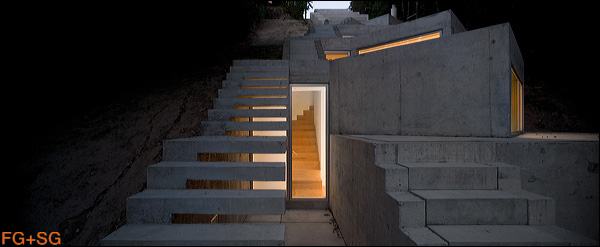
Architects: Alvaro Leite Siza
Client: Luís Marinho Leite Barbosa da Silva
Location: Lugar das Carvalhinhas – Alvite, freguesia de Cerva, Ribeira da Pena District
Site Area: 1000 sqm
Constructed Area: 180 sqm
Contractor: óscar Gouveia
Landscape: Alvaro Leite Siza Vieira
Materials: Concrete
Services: GOP
Project Start: 2000
Project Complete: 2005
Photographers: Alvaro Leite Siza / F&S Guerra
建筑师:如雷贯耳西扎大爷
客户:马里尼奥雷特巴博萨达席尔瓦(google翻译葡萄牙语)
地点:地点香科 - Alvite,邻里塞尔瓦,里韦拉达佩纳区(同上,好有大航海风味的地名)
基地面积:1000平方米
建筑面积:180平方米
承包商:奥斯卡·乔维亚
景观设计:西扎大爷
材质:混凝土
监理:GOP
项目初始:2000
项目完工:2005
摄影:西扎/嗯?
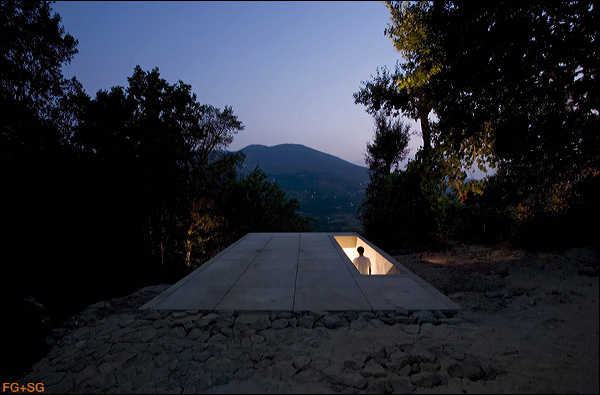
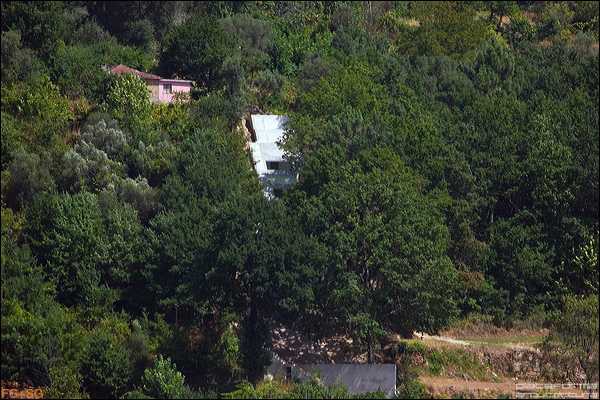
This project is located on a site, with an area of around 1000m2, in Lugar das Carvalhinhas – Alvite, Cerva Parish, Ribeira da Pena Commune, Vila Real District.
The project consists of a holiday home with three bedrooms, a social bathroom, a living room, a dinning room, a small kitchen with a support washbasin, pantry, and even a small outdoor swimming pool.
The terrain is sharply inclined and has a particular configuration: it is very long and narrow. However, the fact that it faces south allows it to receive optimal solar exposure and to enjoy a particular natural view. The living area does not exceed 180m2.
For reasons of functionality and integration, it was opted to organize the main entrance based on the street where car transit was possible. This road leads to the northern higher part of the lot. Nevertheless, it is possible to access the house from a more rustic footpath from the south. Its fragmentation, necessary due to the steep topography, transforms the whole into a composition of small linked and interconnected volumes, creating an unevenness that allows for a more secure and rational use of the lot. In this way the house’s various functions are clarified with each elevation corresponding to a single compartment. The roof functions simultaneously as pavement support for the gardens: similar to the traditional threshing floors and patios in the northern regions of the country with hilly terrain.
With a linear position at the center of the lot, an attempt was made to preserve all the pre-existing trees, as they maintain a strong presence in the area, as well as to preserve continuity with the immediate surroundings and to ensure its original characteristics. The form resulting from a rigorous, modular geometric abstraction establishes the necessary rotation of certain modules to adapt to the natural morphology of the terrain, respecting the distance from neighboring regulation walls, thus appearing to move naturally and with absolute freedom.
The terrain’s instability together with modest economic resources gave rise to a house with triple function: the home itself and its interior space; the organization of outdoor leveled patios corresponding to the roofs of various levels which permit the outdoor use of the garden; and finally, the creation of a pedestrian link between the paths of the upper and lower levels that border this lot. In this way the house itself is a path. Its form organizes a fundamental outdoor route. The exterior stairs that create a link between the patios mirror the interior stairs that have the same function of linking the designed compartments that are also developed through levels. In this way, the exterior stairs correspond to the interior ceilings.
Although this project presents an extreme unit in its language, from the four quadrants, its image varies completely. It expresses its entire volumetry to the southeast, and in a different way to the northeast. It is radically contextualized in the northwest and southwest quadrants. It is neither horizontal nor vertical architecture. Its location on the lot results in a slanting architecture.
The necessity of partially burying the house comes from lack of economic means, and in this way creates positive thermal behavior and security. The outdoor patios solidly adapt, establishing a direct link to the garden, and the house is naturally unified with the terrain. The choice of exposed concrete creates an idea like that of massive stones appearing naturally on the site. In this way, expressiveness is extracted from a continuous structure of reinforced concrete, the most efficient on the lot with these characteristics, and once again making optimum use of the modest economic resources available.
Paving stones of reinforced concrete will also be constructed, creating an air space between these and the lot, which is fundamental for guaranteeing decent waterproofing and improved thermal behavior in the terrain with such an elevated water table. The reinforced concrete walls will contain an exterior finishing with special formwork, its stereotomy having been designed. PVC canvases will waterproof foundations, walls, and roofs.
The roofing will be covered with thermal insulation and prefabricated, anti-slip tiles. Some patios will be filled with humus for a grass plane. The few non-resistant walls will be built in cement blocks filled with sand. These will be plastered, coated and painted white in the interiors.
The interior floors, doors, and baseboards are in wood, except in the water areas. The exterior doors and windows are in metal, which are double-pained for improved thermal and acoustic insulation.
The photographic references are relative to the site on the internet: http://www.fernandoguerra.com/tolo/
For publishing them, you should contact the photographer Fernando Guerra.
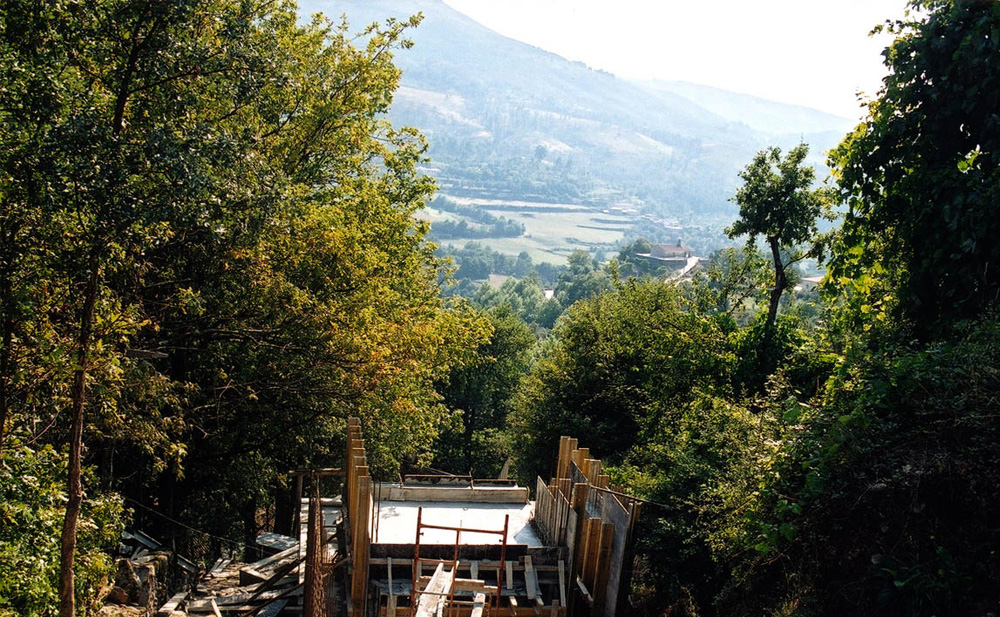
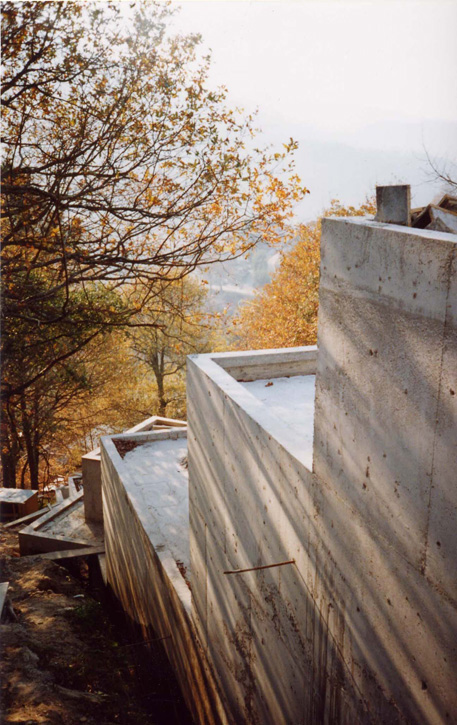
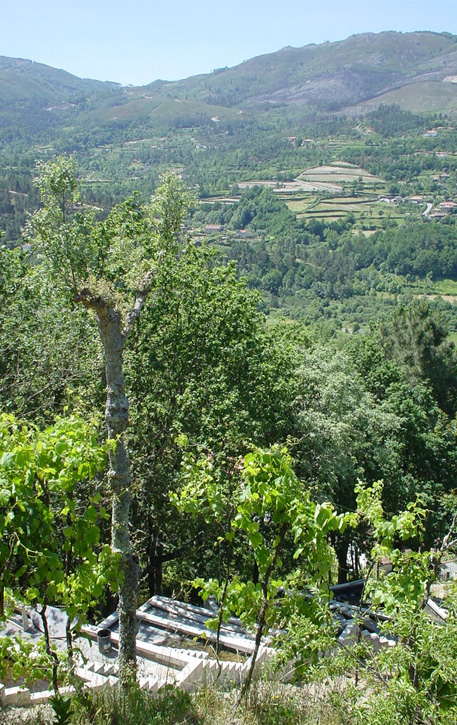
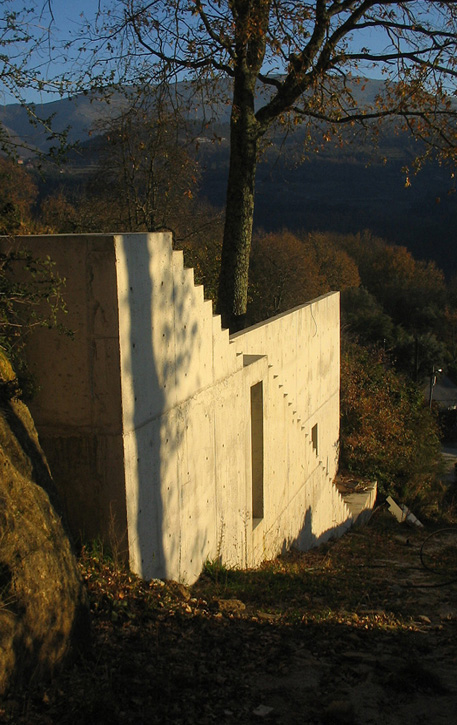
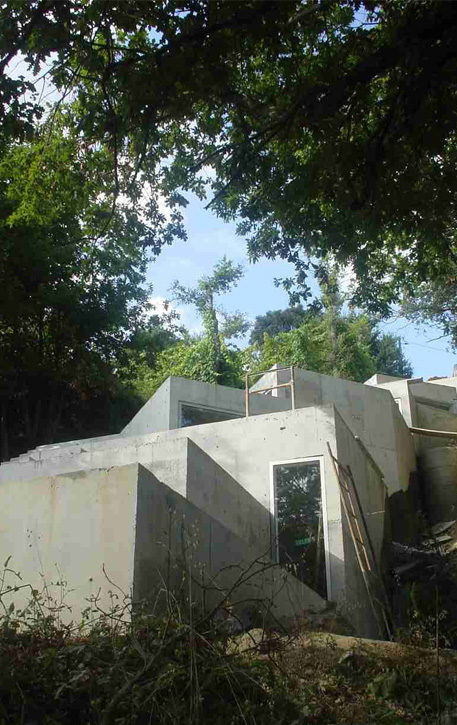
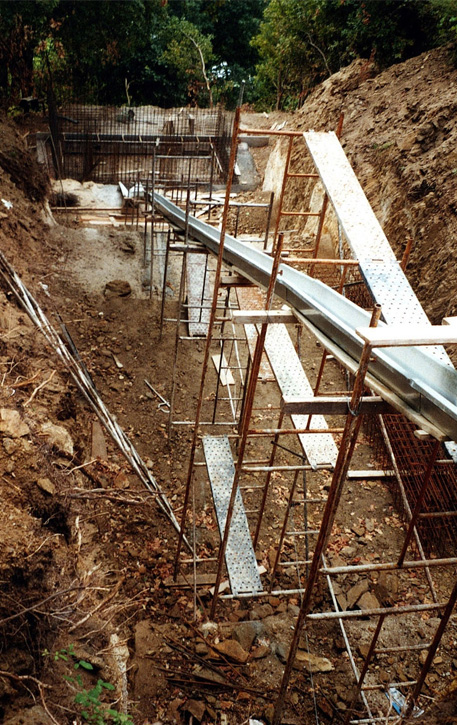
该项目基地面积大约1000m2,位于葡萄牙某旮旯。
该项目为一座度假家庭别墅,包括三个卧室,一个公用浴室,一个起居室,一个餐厅,一个有洗槽和备餐室的厨房,甚至还有一个小型室外泳池。
基地地势陡峭且形貌独特,呈细长状。幸得坐北朝南以使其获得最佳日照条件与独特的自然景观。生活区域面积不超过180m2。
由于功能需要及为了与环境相协调,主入口被安置在可以行车的街道上。该道路通向该地段的北部高地,因此,你也可以选择从基地南面的乡间小径进入这座住宅。这种被功能被割裂的状态得益于陡峭的地势,拜其所赐这个住宅整体被转换成为更小的相互关联的体块的组合,为了更妥善并且合理地利用该地块而创建了一个不平衡的体系,如此一来这座住宅的每个独立分格的立面所表明的既是该分格的功能。屋顶同时具备了通向花园的路面的功能:这与该国北部丘陵地区传统的晒谷场与院子十分相似。
纵使建筑主体贯穿基地的中轴线,建筑师仍试图尝试保留基地中已存在的树木,因为这些树木表现出的强烈的存在感,同时也是为了与周边环境保持连贯以保证维持地块原有的特征风貌。由严格的模块化的几何抽象而来的形式决定了将某些体块做必要的旋转以适应基地的自然形态,同时由于距边界控制围墙仍有相当一段距离,因此这种移动显得自然毫不做作且绝对自由。
善变的地形与有限的资金投入赋予这座住宅三重功能:住宅本身及它的室内空间;各个标高上通向花园的屋顶充当室外院子的组织手法;以及在地块边缘敷设行道并在高差较大出设置踏步相衔接的作法。如此一来这座住宅自身就成为了一条行道,用自身形式组织出一条大致的户外通道。链接院子的室外阶梯映射着具有相同功能既将随地势发展的体块衔接起来的室内楼梯,并以这种方式与室内天花相持平。
因此这个项目用它自己的语言呈现了一个极端的个例,从四个朝向上看去的景象不尽相同。站在东南方向你能看到它的全貌,然后在东北方向则完全是另外一幅景象。从西北和西南方向上看去则彻底地被周遭景色所覆盖。它既不是水平方向上也不是垂直方向上的建筑,它所处的地块决定了它是一座倾斜的建筑。
由于缺乏经济手段,因此有必要将房体的一部分埋入地下以获得积极的热工措施与保障。与花园直截连结的室外庭院亦完全符合这一原则,再者这座住宅也毫丝无间与地形融为一体。选择将混凝土直接暴露于户外则为意图创造一种石块在基地上堆砌的类似自然的效果。这是仅仅从钢筋混凝土的连续结构中即可释放出的表达效果,这使它成为在这块基地上获取这些特质的有效直接的手段,同时又使有限的资金投入获得了最优佳利用。
同时还要铺设钢筋混凝土铺地在地基与建筑之间增设一道空气层以保障基层防水,并连同层层跌落的泻水台一起改善地块的热工环境。钢筋混凝土墙将用特殊模板做外观处理,块材的分割也经过了事先设计。PVC防水布用于基础、墙面和屋顶的防水处理。
屋面将铺设热绝缘预制防滑瓷砖。某些庭院将铺设种植土以种植草坪。非承重墙将用加砂水泥砌块砌筑。室内墙体及天花则会在平整之后漆成白色。
除了亲水区域,室内的地板、门和踢脚均以木材制成。室外门窗均为金属框声热绝缘双层玻璃。
参考图片来自该网站请猛击:http://www.fernandoguerra.com/tolo/
如需公开发表,请联系摄影师Fernando Guerra。 |
|